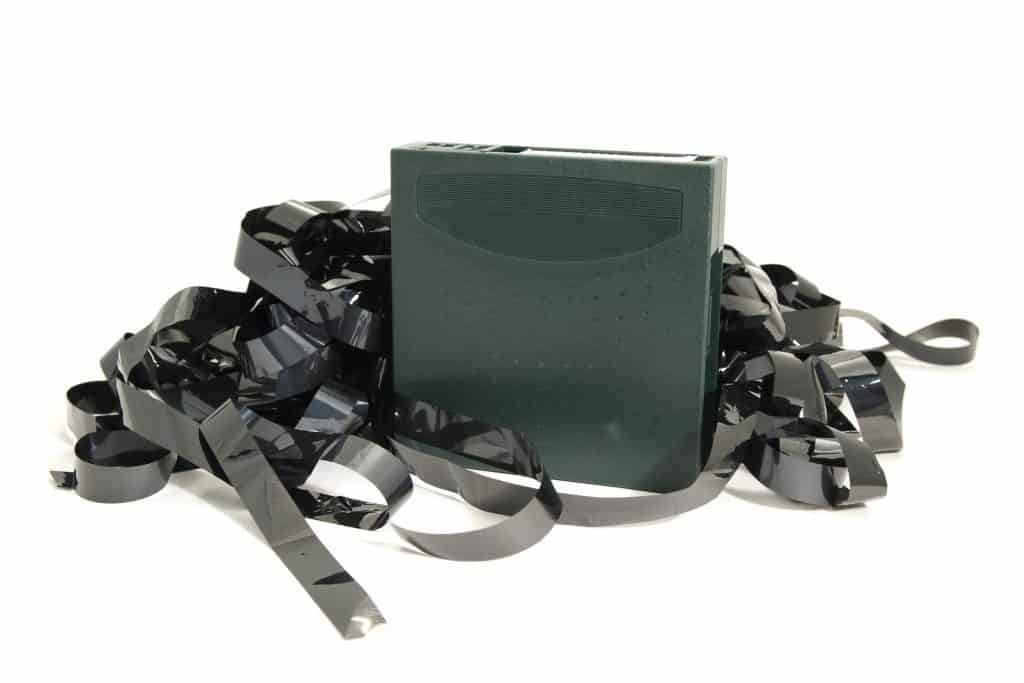Digital Linear Tape (DLT)
Digital Linear Tape (previously called CompacTape) is a magnetic tape storage device meant to balance cost, capacity, and longevity. DLT was originally developed in 1984 by the Digital Equipment Corporation (DEC), which was later acquired by Quantum. As of 2007, Quantum is no longer developing DLT tapes, but they are still available for purchase. DLT tapes are made of metal particle tape, and they also have a lifespan of up to 50+ years.

Here are some common problems that can occur with magnetic storage tapes:
- Dropping or Jostling Damage
- Water Damage
- Damage Caused by Extreme Temperatures
- Exposure to Excessive Humidity
- Overwritten Data
- Deterioration over Time
- Degraded Media
- Internal Mechanism Failure
Gillware has almost two decades of experience in recovering data from any number of mediums, and we have dealt with DLT many times before. Most of the tapes we modernize or recover from are old or vintage, so we’ve encountered decades-old tapes many times and we can perform any service you might need done on them. Get a free estimate on the cost of your DLT tape data conversion here.

Digital Linear Tape (DLT) Tape Features and Versions
DLT tapes are WORM capable, meaning that they can be read many times but only written once, which prevents accidental overwriting of valuable data. If you wanted to get rid of the written data on (most) WORM-enabled tape, you can degauss it (reduce the magnetic field), which will leave you with a clean tape that can be reused to store more data. But be careful not to put a valuable tape too close to a large magnet; this could unintentionally degauss it and erase the data on the tape. Degaussing can also make some tapes unusable, though most will be fine. Make sure to research what degaussing does to the type of tape you intend to erase before doing it.
The latest version of regular DLT is DLTtape IV, which was launched in 1994 and has a capacity of up to 20GB per tape. All DLT tapes write linear serpentine data tracks that span the length of the tape and run parallel to its edges. DLT tapes can have either 128 or 208 of these linear tracks. Super DLTtape is a slightly different version, made to accommodate even more storage space. It was launched in 2001 and originally could hold 110GB of data. As of Super DLT II that number is now 300GB. Super DLT technology uses optical-assist servo technology, which aligns the read and write heads to the proper tracks visually.
Digital Linear Tape (DLT) Drawbacks
Of course, this technology is fragile and can get damaged easily. For example, if the tape is dropped or jostled too much it can result in the read/write heads becoming misaligned or some other mechanical issue. Trying to fix these issues yourself can lead to them becoming worse, as if you don’t have a cleanroom dust and other particles can get inside the tape and damage the mechanics as well as the tape itself, along with the data stored on it.
Digital Linear Tape Data Recovery with Gillware
Many of Gillware’s clients are large companies who have just discovered a bunch of tapes sitting in storage and don’t know how/don’t have the equipment to get the data off of them, or convert it onto a more modern format. Often, the format on the tape is not compatible with current reading equipment, and that’s where Gillware comes in. We have all the necessary tools and equipment, a state-of-the-art cleanroom, and a team of highly trained software engineers ready to tackle recovering the data from your tapes or converting them into a modern format.
Need to Recover Data from Digital Linear Tape (DLT)?
Talk to an expert about your tape data recovery needs and getting your data back. Get a no-hassle consultation today!

